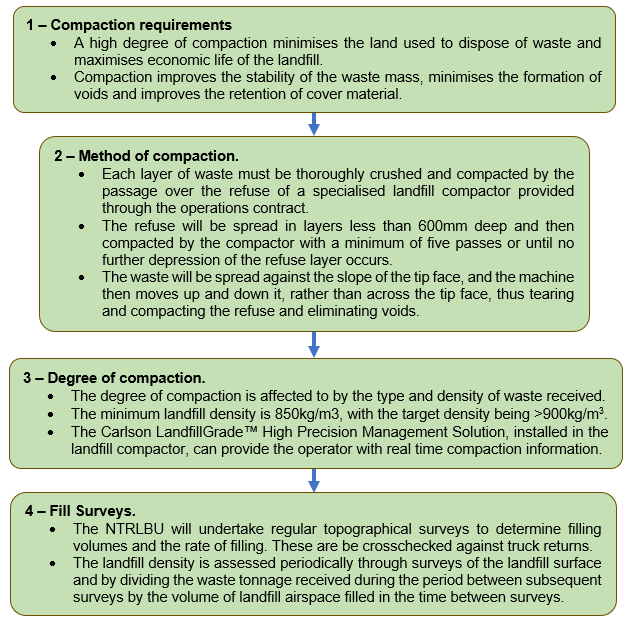-
-
11/24 - Page uploaded from Word document Waste Draft 5.
-
More detail required on link between compaction and stability.
Procedures and detail needs to be updated for new Compactor used from 2024.
Unclear what the minimum landfill density is. LMP refers to 750kg/m3 but Kim reviewed with 850kg/m3, with the target density being >900kg/m3.
-
Please send updates, changes and comments to landfill@ncc.govt.nz
Compaction of Waste
Disclaimer: These procedures guide the operation of YVLF. They are intended as working documents that are improved through operational experience and updated accordingly. Please send updates, changes and comments to landfill@ncc.govt.nz
Flowchart
Procedure
-
A high degree of compaction is to be achieved to maximise the economic life of the void space. [LMP 2023 Chapter 3.6]
The amount of landfill space and land used to dispose of waste can be minimised by compaction. [Technical Guidelines for Disposal to Land, WasteMINZ, Revision 3.1, 2023, Chapter 7.8]
Compaction improves the stability of the waste mass and minimises the formation of voids that can encourage vermin or result in fires or excess generation of leachate. [Technical Guidelines for Disposal to Land, WasteMINZ, Revision 3.1, 2023, Chapter 7.8]
Waste should be placed and compacted to ensure that unconfined faces are stable and capable of retaining cover material. [Technical Guidelines for Disposal to Land, WasteMINZ, Revision 3.1, 2023, Chapter 7.8]
-
Each layer of refuse shall be thoroughly crushed and compacted by the passage over the refuse of a specialised landfill compactor provided through the operations contract. [LMP 2023 Chapter 4.8.1]
The refuse will be spread in layers less than 600mm deep and then compacted by the compactor with a minimum of five passes or until no further depression of the refuse layer occurs. [LMP 2023 Chapter 4.8.1]
The refuse will be spread against the slope of the tip face, and the machine then moves up and down it, rather than across the tip face, thus tearing and compacting the refuse and eliminating voids. [LMP 2023 Chapter 4.8.1]
If large loads of organic material or special wastes are received, they will be spread and compacted near the bottom of the face so that more resilient refuse can be compacted on the top. [LMP 2023 Chapter 4.8.1]
-
The degree of compaction is affected to some degree by the type and density of waste received but where efficient compaction methods are applied variations in final density will be minimised. Considering the waste types and volumes received at York Valley Landfill, the expected minimum density to be achieved is at least 750 kg/m³. [LMP 2023 Chapter 4.8.2]
The minimum landfill density is 850kg/m3, with the target density being >900kg/m3.
The Carlson LandfillGrade™ High Precision Management Solution, installed in the landfill compactor:
can provide the operator with real time information. [LMP 2023 Chapter 4.8.2]
allow site supervisors and operators to track compaction in real-time with colour mapping using pass counts or vertical deflection.[https://www.carlsonsw.com/product/carlson-landfill-grade]
-
Regular topographical surveys shall be undertaken by the NTRLBU as necessary to determine filling volumes and the rate of filling. These shall be crosschecked against truck returns. [LMP 2023 Chapter 4.12]
The landfill density is assessed periodically through surveys of the landfill surface and by dividing the waste tonnage received during the period between subsequent surveys by the volume of landfill airspace filled in the time between surveys. [LMP 2023 Chapter 4.8.2]
The compaction density calculation is worked out over a period between X month and Y month:
Compaction Density in period X-Y (t/m3) = Waste Tonnes in period X-Y (t) / Landfill Volume used in period X-Y (m3)
Note that the volume of landfill used includes for cover material. Some landfill managers choose to subtract the volume occupied by the cover material. This requires an estimate of the cover material volume, which may also require a weight of cover material to be converted to a volume by assuming a cover material density. [LMP 2023 Chapter 4.8.2]
Reference
-
The exposed area of landfill shall be kept to a minimum at all times and refuse placed in the landfill will be compacted using suitable compactor equipment and shall be covered as soon as practicable by clay bound fill materials. Nelson City Council will ensure that there is no wind-blown refuse or objectionable elements from the presence of birds, vermin or smell. Refuse shall not be left uncovered following each day’s closure of the landfill.

